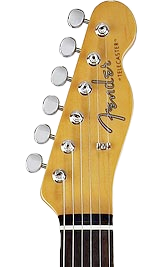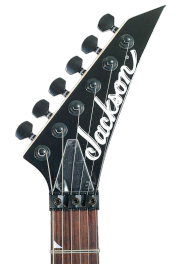Guitar Tuning.
This page will help give you the idea. When you come to a lesson this will be gone through in much more detail, and include other tunings than standard for intermediate and advanced players.
Guitars With A Standard Nut.
When tuning a guitar with a standard nut (like the one on the left), using the machine heads to tune the guitar, there is one significant point that will help, even when using a tuner to help judge the pitch of each string. Tune up to the note! It may not seem like a big thing, but there is a very good reason to take this approach. While you tune, the string you are tuning slips across the nut as the string is stretched. If you loosen the string to tune down to the note, the friction of the string across the nut will leave the tension of the string behind the nut lower than the rest of the string. As soon as you bend the string, the string will be pulled across the nut making the string go flat! Tuning up to the note is the answer.
Guitars With A Locking Nut.
A locking nut like the one on the right here, is quite a different proposition. With this type of nut, you not only have the machine heads to tune the guitar, but you have fine tuners as part of the bridge (tremolo) system. These are used for any fine tuning required while the locking nut is locked. The locking of the nut prevents the string movement across the nut, preventing any change in tuning due to use of the tremolo system. Use these to tune the strings, tuning up or down to the correct note.If there is not enough adjustment available to get the guitar in tune, then the locking nut is unlocked (usually with the use of a 3mm allen key). The fine tuners are then re-set to the middle of their adjustment before the guitar is put in tune using the machine heads. The nut is then locked again, and the fine tuners used to accurately tune the guitar.
Tuning The Guitar To Itself.
This is the option used when you don't have a tuner to hand. Tuning forks only help you tune one string, then you'll use one of the methods of tuning the guitar to itself. We will use fretted strings first, and then use harmonics (more accurate).We will assume for this you have the low (low in pitch) e-string or 6th string in tune, and we will go through the strings. The difference in pitch between the E (6th) string and the A (5th) string should be five semitones, so we fret the E string on the 5th fret, and compare that with the open (un-fretted) A string. Tune the A string until the 2 strings are giving you the same note. The A string is then in tune with the E string! Now we use the same method to go through the strings, with one exception, and that is when we tune the B (2nd) string to the G (3rd) string. there is only supposed to be a 4 semitone difference, so the G string is fretted on the 4th fret. Make sure you go through the strings more than once, until you don't have to tune any of the strings.
Next we will describe the method using harmonics. This is a very accurate method, provided you have the first string accurately in tune. Even if you don't, the guitar will sound great on it's own, but not necessarily with anything else! As this doesn't rely on exactly how you fret the strings and is less affected by their age, it is more reliable. Again for ease of explanation, we will assume the E (6th) string is in tune. To play the first harmonic, you play the string, and with your fretting hand, lightly touch the E string right over the 5th fret, releasing the touch on the string just after playing it. You will get a high pitched note from this (2 octaves higher than the open string in this case). Quickly play the A (5th) string using the harmonic from over the 7th fret. These 2 harmonics should be the same in pitch. Tune the A string, and when you get close, you will hear beats between the notes, and when the beats slow down and then stop, you have the 2 strings in tune. Use this method to tune the D (4th) to the A string, and the G string to the D string (5th fret harmonic on the lower pitched string, and 7th fret harmonic on the higher pitched string). For the B string, tune that played open (un-fretted) to the E (6th) string 7th fret harmonic, and the E (1st) string played open to the A string 7th fret harmonic. This takes time to get used to, but really is a great way to tune the guitar.
© 2014 Karn Broad Contact Karn
